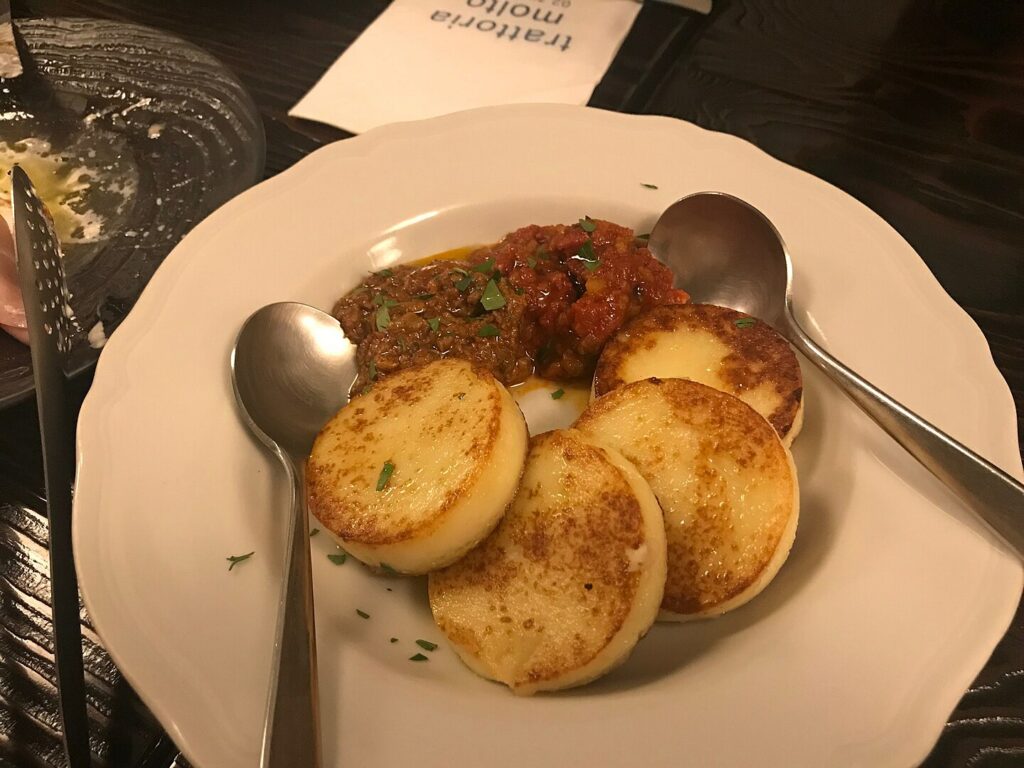When one thinks of Italian cuisine, gnocchi often comes to mind: they are comforting and delicious, and go well with plenty of sauces. Unlike the harder, durum wheat pasta varieties, gnocchi are soft, pillowy dumplings, made using a wide range of ingredients and many regional variations exist: from the traditional potato gnocchi to those made with spinach and ricotta, all the way to the iconic gnocchi alla romana, made with semolina. The history and evolution of this dish is long and interesting, and it deserves to be told…
Some history
First recorded in Renaissance-era cookbooks in the 16th century, early versions of gnocchi were made without potatoes; these first first recipes were created by Renaissance chefs like Cristoforo Messisbugo and Bartolomeo Scappi, and included ingredients like flour, breadcrumbs, and even ground almonds. The dumplings were then boiled and seasoned with butter, cheese, and spices.
These early versions were quite different from the potato-based gnocchi that became popular in later centuries but were no less beloved by the noble families of the time.
Over time, various forms of gnocchi emerged, influenced by both local ingredients and cooking methods. What we recognize as the potato-based gnocchi today only came into being much later, around the late 18th century, after the introduction of the potato to European diets.
The introduction of potato gnocchi
Although present in Italy since the 16th century, the potato, didn’t become a widespread ingredient until the late 1700s. Gnocchi made with mashed potatoes were first mentioned in Italian cookbooks during this period, signaling a shift from the heavier flour-based versions. The recipe called for boiled potatoes to be mashed and combined with flour, eggs, and sometimes cheese, producing the delicate and soft dumplings we know today. However, even in the early 20th century, potato gnocchi were just one of many variations, with other versions, including those made from semolina, chestnuts, or even pumpkin, still holding strong.
Gnocchi’s many varieties
One of the most fascinating aspects of gnocchi is how varied they are across Italy: today, you can find three main categories: potato gnocchi, semolina-based gnocchi (like gnocchi alla romana), and bread-based gnocchi, such as the German-influenced canederli. Each has its unique story, shape, and texture, and demonstrate the creativity and diversity of Italian cuisine.

For example, gnocchi alla romana are made using semolina flour, milk, and eggs. Unlike potato gnocchi, they are baked rather than boiled and often served with butter and cheese. This particular variation, as its name testifies, is traditional of Lazio and has been around since the 19th century.
The canederli, or bread dumplings, are a product of northern Italy’s historical ties with Germanic-speaking regions. The word itself comes from the German “knödel,” meaning dumpling. These gnocchi, often filled with spinach or speck, are served either in broth or with melted butter and sage, and they well reflect the hearty, rustic cuisine of the Alps.

Lesser-known varieties
While potato gnocchi and gnocchi alla romana remain widely recognized, history records many other gnocchi varieties that have fallen out of fashion but were once equally popular. For instance, gnocchi all’acqua were made using a dough similar to that of modern-day choux pastry, combining water, butter, and flour, and then dropped into boiling water. In some regions, gnocchi were even made with polenta or chestnut flour, offering a distinct flavor profile that reflected the ingredients available at the time.
Even more interesting are variations like gnocchi di riso (rice-based gnocchi) or gnocchi di ceci (chickpea-based), which were not uncommon in past centuries but have since faded from common use. However, many of these older recipes, which are recorded in historical cookbooks, are being revived by chefs today as part of the growing interest in traditional Italian cuisine.
Gnocchi today
Today, gnocchi continue to evolve and inspire new interpretations around the world. While Italian grandmothers –our beloved nonne — still hand-roll gnocchi on wooden boards, many chefs are taking liberties with traditional recipes by incorporating modern techniques and ingredients: you’ll find gnocchi made with sweet potatoes, spinach, and even gluten-free options.
In restaurants, gnocchi might be pan-fried for extra crispiness or served with a range of innovative sauces, from truffle cream to spicy arrabbiata.
Despite these innovations, one thing remains constant: gnocchi’s ability to comfort and satisfy, nevermind where they are served!
